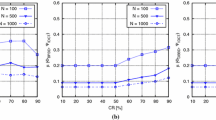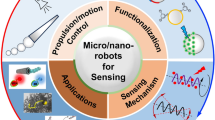Abstract
In wireless sensor networks, the goal is to gather information from a large number of sensor nodes and communicate the information to the end-user, all under the constraint of limited energy resources. Network protocols minimize energy by using localized communication and control and by exploiting computation/communication tradeoffs. In addition, data fusion algorithms such as beamforming aggregate data from multiple sources to reduce data redundancy and enhance signal-to-noise ratios, thus further reducing the required communications. We have developed a sensor network system that uses a localized clustering protocol and beamforming data fusion to enable energy-efficient collaboration. We compare the performance of two beamforming algorithms, the Maximum Power and the Least Mean Squares (LMS) beamforming algorithms, using the StrongARM SA-1100 processor. Results show that the LMS algorithm requires less than one-fifth the energy required by the Maximum Power beamforming algorithm with only a 3 dB loss in performance, thus showing that the LMS algorithm is better suited for energy-constrained systems. We explore the energy-scalability of the LMS algorithm, and we propose an energy-quality scalable architecture that incorporates techniques such as variable filter length, variable voltage supply and variable adaptation time.
Similar content being viewed by others
References
K. Bult, A. Burstein et al., “Low Power Systems for Wireless Microsensors, ” IEEE/ACM International Symposium on Low Power Electronics and Design, 1996, pp. 17–21.
K. Yao, R. Hudson et al., “Array Signal Processing for a Wireless MEM Sensor Network, ” 1998 IEEE Workshop on Signal Proc.Systems, invited paper, pp. 11–20.
J. Capon, “High-Resolution Frequency-Wavenumber Spectrum Analysis, ” in Proc.of IEEE, vol. 57, 1969, pp. 1408–1418.
A. Van Der Veen, “Algebraic Methods for Deterministic Blind Beamforming, ” in Proc.of the IEEE, vol. 86, no.10, 1999.
C.L. Nikias and M.R. Raghuveer, “Bispectrum Estimation: A Digital Signal Processing Framework, ” in Proc.of the IEEE, vol. 75, no. 7, 1987.
http://www-mtl.mit.edu/research/icsystems/uamps/index.html
V. Tiwari and S. Malik, “Power Analysis of Embedded Software: AFirst Approach to Software Power Minimization, ” IEEE Trans.on VLSI Systems, vol. 2, 1994, pp. 437–445.
A. Sinha and A. Chandrakasan, “Energy Aware Software, ” VLSI Design 2000, Calcutta, India, Jan. 2000.
T. Rappaport, Wireless Communications: Principles and Practice, New Jersey: Prentice Hall, 1996.
T. Meng and R. Volkan, “Distributed Network Protocols for Wireless Communication, ” in Proceedings of the IEEE ISCAS, May 1998.
T. Shepard, “A Channel Access Scheme for Large Dense Packet Radio Networks, ” in Proceedings of the ACM SIGCOMM, Aug. 1996, pp. 219–230.
S. Singh, M. Woo, and C. Raghavendra, “Power-Aware Routing in Mobile Ad Hoc Networks, ” in '98), Oct. 1998.
W. Heinzelman, A. Chandrakasan, and H. Balakrishnan, “Energy-Efficient Communication Protocol for Wireless Microsensor Networks, ” in Proc. '00, Jan. 2000.
K. Yao, R. Hudson et al., “Blind Beamforming on a Randomly Distributed Sensor Array System, ” IEEE Journal on Selected Topics in Communications, vol. 16, no. 8, 1998.
S. Haykin, J. Litva, and T.J. Shepherd, Radar Array Processing, Berlin: Springer-Verlag, 1993.
S.H. Nawab and A.V. Oppenheim, “Approximate Signal Processing, ” Journal of VLSI Sig.Proc.Systems, vol. 15, no. 1, 1997.
J. Goodman, A. Dancy, and A.P. Chandrakasan, “An Energy/ Security Scalable Encryption Processor Using an Embedded Variable Voltage DC/DC Converter, ” IEEE Journal of Solid-State Circuits, vol. 33, no. 11, 1998.
M. Goel and N.R. Shanbhag, “Low-power Equalizers for 51.84 Mb/s Very High-Speed Digital Subscriber Loop (VDSL) Modems, ” 1998 IEEE Workshop on Signal Proc.Systems, pp.317–326.
C.J. Nicol, P. Larsson, K. Azadet, and J.H. O'Neill, “A Low Power 128-Tap Digital Adaptive Equalizer for Broadband Modems, ” 1997 IEEE International Solid-State Circuits, pp. 94–95.
W. Rabiner Heinzelman, J. Kulik, and H. Balakrishnan, “Adaptive Protocols for Information Dissemination in Wireless Sensor Networks, ” in '99), Aug. 1999, pp. 174–185.
V. Gutnik and A.P. Chandrakasan, “Embedded Power Supply for Low-Power DSP, ” IEEE Trans.on VLSI Systems, vol. 12, 1997, pp. 425–435.
Author information
Authors and Affiliations
Rights and permissions
About this article
Cite this article
Wang, A., Heinzelman, W.B., Sinha, A. et al. Energy-Scalable Protocols for Battery-Operated MicroSensor Networks. The Journal of VLSI Signal Processing-Systems for Signal, Image, and Video Technology 29, 223–237 (2001). https://doi.org/10.1023/A:1012235530463
Published:
Issue Date:
DOI: https://doi.org/10.1023/A:1012235530463




